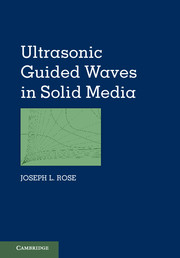Book contents
- Frontmatter
- Contents
- Nomenclature
- Preface
- Acknowledgments
- 1 Introduction
- 2 Dispersion Principles
- 3 Unbounded Isotropic and Anisotropic Media
- 4 Reflection and Refraction
- 5 Oblique Incidence
- 6 Waves in Plates
- 7 Surface and Subsurface Waves
- 8 Finite Element Method for Guided Wave Mechanics
- 9 The Semi-Analytical Finite Element Method
- 10 Guided Waves in Hollow Cylinders
- 11 Circumferential Guided Waves
- 12 Guided Waves in Layered Structures
- 13 Source Influence on Guided Wave Excitation
- 14 Horizontal Shear
- 15 Guided Waves in Anisotropic Media
- 16 Guided Wave Phased Arrays in Piping
- 17 Guided Waves in Viscoelastic Media
- 18 Ultrasonic Vibrations
- 19 Guided Wave Array Transducers
- 20 Introduction to Guided Wave Nonlinear Methods
- 21 Guided Wave Imaging Methods
- Appendix A Ultrasonic Nondestructive Testing Principles, Analysis, and Display Technology
- Appendix B Basic Formulas and Concepts in the Theory of Elasticity
- Appendix C Physically Based Signal Processing Concepts for Guided Waves
- Appendix D Guided Wave Mode and Frequency Selection Tips
- Index
- Plates
- References
9 - The Semi-Analytical Finite Element Method
Published online by Cambridge University Press: 05 July 2014
- Frontmatter
- Contents
- Nomenclature
- Preface
- Acknowledgments
- 1 Introduction
- 2 Dispersion Principles
- 3 Unbounded Isotropic and Anisotropic Media
- 4 Reflection and Refraction
- 5 Oblique Incidence
- 6 Waves in Plates
- 7 Surface and Subsurface Waves
- 8 Finite Element Method for Guided Wave Mechanics
- 9 The Semi-Analytical Finite Element Method
- 10 Guided Waves in Hollow Cylinders
- 11 Circumferential Guided Waves
- 12 Guided Waves in Layered Structures
- 13 Source Influence on Guided Wave Excitation
- 14 Horizontal Shear
- 15 Guided Waves in Anisotropic Media
- 16 Guided Wave Phased Arrays in Piping
- 17 Guided Waves in Viscoelastic Media
- 18 Ultrasonic Vibrations
- 19 Guided Wave Array Transducers
- 20 Introduction to Guided Wave Nonlinear Methods
- 21 Guided Wave Imaging Methods
- Appendix A Ultrasonic Nondestructive Testing Principles, Analysis, and Display Technology
- Appendix B Basic Formulas and Concepts in the Theory of Elasticity
- Appendix C Physically Based Signal Processing Concepts for Guided Waves
- Appendix D Guided Wave Mode and Frequency Selection Tips
- Index
- Plates
- References
Summary
Introduction
The semi-analytical finite element method (SAFEM) has recently become widely adopted for solving wave propagation problems in waveguides. SAFEM was developed as an alternative approach to more traditional methods such as the global matrix method, primarily because of its benefits of solving arbitrary cross-section waveguide problems (see Hayashi, Song, and Rose 2003). In SAFEM, the waveguide is discretized in the cross section, while an analytical solution is adopted in the wave propagation direction. Based on a variational scheme, a system of linear equations can be constructed with the frequency and wavenumber as unknowns. The unknowns can be solved using standard eigenvalue routines. SAFEM can solve problems of wave propagation in waveguides with complex cross sections, for example, multilayered laminates (Shorter 2004) and rails (Gavrić 1995; Hayashi, Song, and Rose 2003), where it is often difficult to obtain analytical solutions. For waveguides that are infinitely long in one dimension, SAFEM is superior to pure FEM in that exact analytical representations are used for one or two dimensions of the waveguide. Therefore, computational cost is reduced. SAFEM is also advantageous compared to analytical matrix methods because it is less prone to missing roots in developing the dispersion curves. Early employment of SAFEM in solving guided wave propagation problems can be found in Nelson and colleagues (1971) and Dong and colleagues (1972). In recent years, SAFEM was applied to the analysis of wave modes across a pipe elbow (Hayashi et al. 2005) and in materials with viscoelastic properties (Shorter 2004; Bartoli et al. 2006). SAFEM was also utilized to model the composite wing skin-to-spar bonded joints in aerospace structures by Matt and colleagues (2005) and to investigate guided wave propagations in rail structures (Damljanović and Weaver 2004; Lee et al. 2006). Applications of the SAFE technique for guided waves in composite plates can also be found in Liu and Achenbach (1994, 1995), Gao (2007), and Yan (2008).
Information
- Type
- Chapter
- Information
- Ultrasonic Guided Waves in Solid Media , pp. 135 - 154Publisher: Cambridge University PressPrint publication year: 2014
References
Accessibility standard: Unknown
Why this information is here
This section outlines the accessibility features of this content - including support for screen readers, full keyboard navigation and high-contrast display options. This may not be relevant for you.Accessibility Information
- 6
- Cited by
